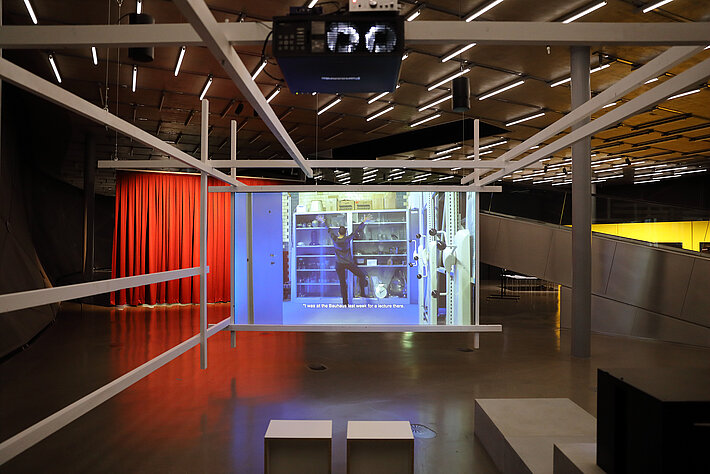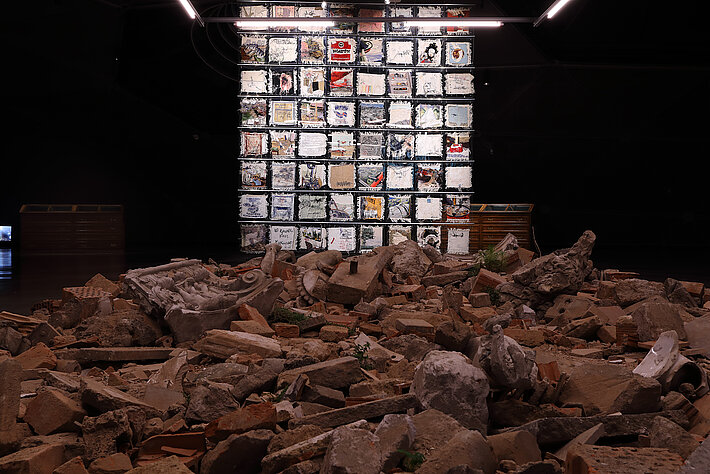|
|
|
|
|
|

"Isa Rosenberger. Shadows, Gaps, Voids", photo: Kunsthaus Graz/J.J. Kucek
|
|
|
The two current exhibitions at Kunsthaus Graz show three important Austrian positions that deal with the extension of social agreements: “Ingrid Wiener, Martin Roth. From far away you see more” and „Isa Rosenberger. Shadows, Gaps, Voids“. While the works of Ingrid Wiener and Martin Roth reexamine the concept of the environment in Space01, Isa Rosenberger's historiographic artistic approach will be on view in Space02.
Historiographic view
Isa Rosenberger’s artistic interest is historiographical, examining the writing of history, its abridgements, suppressions and revisions. More than this: her film installation works often go on a search for traces that will give space and visibility to the hidden, repressed and forgotten, mostly of feminist women’s history.
Rosenberger connects the body knowledge of her female protagonists, both their personal and generation-shaping experiences together with socio-political events in the past and present. The latter are closely linked to Jewish culture and history. Discussions with contemporary witnesses, documentary and fictional modes of narration, performative approaches and (re-)stagings create a network of connections, continuities, interruptions and synchronicities – in short: a multi-perspectival historiography in which gaps and voids are constitutive. Rosenberger ties these in with current issues and discourses: the voluntary or forced migration of people, but also of knowledge, economic crises and critique of capitalism or the creative and self-empowering handling of economic and political adversities. In this way, the present writes itself into the past, and the past becomes alive in the present.
Montage is used in the realisation of her films: the levels of speech, language and visual narration switch, fragment and join up again at other points. This principle is transferred – in spatialised form – to the exhibition itself. Curtains, plinths, wall panels, furniture and film projections are components of the work and at the same time become structuring elements within the exhibition. The separation between artworks and exhibition display fades away: architecture, work and performance are interwoven.
The artist’s most comprehensive show to date features six older works and a new piece, a co-production with the Bauhaus Dessau Foundation. Together they form the spatial, visual and content framework for the exhibition scenography. The exhibition space provides the stage for a production in various scenes, and in the process becomes the scenery itself.
|
|
|
|
|
|
|
|
|
|
|
|
Ingrid Wiener and Martin Roth: Two generations of artists
Two artists, two generations. And two first major institutional retrospectives that complement each other in their conceptual approaches and shake up the central perspective on humans. “The centre no longer exists,” says Rosi Braidotti, the great philosopher of the posthuman. Instead, there is the factor of time and a pressing question of the responsibility and solidarity of the individual. The exhibition juxtaposes two positions that see the environment, the world around us, as a growing symbiosis. Disciplines are questioned, expanded and interwoven. One artist weaves what she sees, she draws and writes what she dreams, takes photos from a plane and is famous for her cooking. The other, almost two generations younger, begins with painting, expands it, builds landscapes and devotes himself to conceptual art and minimal art from the perspective of all living things. Carpets overgrown with grass, animals as workers in artificially clean worlds, ducks mapping the studio. What unites both is the inclusive and eternally inquiring gaze from a distance.
The exhibition at Kunsthaus Graz brings together the works of Ingrid Wiener and Martin Roth, giving rise to a world of wondrous networks beyond anthropocentrism. It shows Ingrid Wiener’s dream drawings, many of her most important tapestries from 1985 to 2023, but also a series of photos and a number of films created in exchange with others and her immediate environment. Wiener’s works are juxtaposed with a series of interactive and reactivated sound installations, films and two-dimensional works by Martin Roth. In his work until 2019 he gave the organic – the animal and the plant – supporting roles in a collaborative approach.
The Austrian artist Martin Roth died far too early, having already attracted international attention with his site-specific installations and interventions between art and nature. His ephemeral and temporary spaces, sometimes apocalyptic-dystopian scenes made of rubble, bricks or the waste of civilisation, are critical examinations of a society of abundance and privilege. Ohne Titel (Bonsai), the first work in the exhibition by Martin Roth, explores precisely this theme of cultivation. The two-part work consists of a minimalistically staged bonsai and a harmonious soundscape made by animals in the basement. Here the consequences of domestication are made clear, focusing attention on the invisible collaborators of cultural production. In the work’s reactivation for the Kunsthaus, the animals will only be kept here for a short time for reasons of animal welfare. Having lived in a cage, they will then find a more species-appropriate home at Tierpark Herberstein. Following this, there will be acoustic recordings and an educational discussion about the living conditions of creatures will form part of the broad programme at the exhibition centre.
|
|

Ingrid Wiener and Martin Roth: Two artists, two generations, photo: Kunsthaus Graz/J.J. Kucek
|
|
|
|
|
|
|
|
|
|
|
|
|
Ingrid Wiener's practice of weaving
Over the decades, Ingrid Wiener has practised weaving in all living environments and produced many tapestries in which she interweaves the process of seeing with the time-intensive process of weaving. In doing so, she has created a specific technique that expands the possibilities of figurative painting as “seeing through the warp”. Here she shows both the constantly displaced gaze and also weaving itself as a process. Hence the exhibition opens – echoing Roth’s inclusive view of his environment – with her important work Windowview (1985-87), which exaggerates the painterly topos of the view out of the window, and through the aspect of time expands it into multifocal seeing.
Since 1995, Ingrid Wiener has been creating watercolours of imaginary images in dreams. Her filigree drawings on paper, lightly and fragmentarily painted with watercolour, blithely capture a flow of images. Standing in contrast to Roth’s expanse of debris we find her monumental collaboration with Dieter Roth (1991 - 1996). 64 individual tapestries – the result of an exchange of letters between Canada and Iceland, here becoming a monument to the inclusion of the everyday. Everything is gathered here, flat waste together with views from the window and into the past.
Part of the exhibition is dedicated to Wiener’s life in Alaska. She depicts powerful natural landscapes which – from the plane, behind the camera and at the loom – celebrate humans in their spirit of adventure while at the same time rendering them small and ephemeral.
Interwoven in the exhibition space, Wiener’s complex weaving or sound works emphatically point to the dimension of time. Artistic work is shown here as an exploratory process: the themes of constant development, nurture and interaction run through both work complexes. So it is that the show creates, on one hand, an artistic dialogue about artistic creation beyond traditional values and, on the other hand, expresses the symbiosis of living things, in which time, space and matter interweave.
In both work complexes, the combination of the supposedly incompatible also represents a plea for an open society in solidarity, transcending rigid hierarchies and demarcations. It shows a world that reminds us of Donna Haraway’s prominent Chthulucene, in which humankind seems ephemeral – well positioned not at the centre but at the edges of these constantly evolving structures: observing, enabling and learning.
________________________
Ingrid Wiener, Martin Roth
From far away you see more
Duration: 10.02.–21.05.2023
Curated by Katrin Bucher Trantow, Michaela Leutzendorff Pakesch
Venue: Space01
Isa Rosenberger
Shadows, Gaps, Voids
Duration: 10.02.–01.05.2023
Curated by Barbara Steiner (Stiftung Bauhaus Dessa), Alexandra Trost (Kunsthaus Graz)
In cooperation with Stiftung Bauhaus Dessau
Venue: Space02
More information and images for download are available under:
Ingrid Wiener, Martin Roth
Isa Rosenberger
Kunsthaus Graz, Lendkai 1, 8020 Graz
www.kunsthausgraz.at
________________________
We look forward to your reports and articles and will be happy to answer any questions!
With best regards
Daniela Teuschler
+43/664/8017 9214, daniela.teuschler@museum-joanneum.at
Stephanie Liebmann
+43/664/8017-9213, stephanie.liebmann@museum-joanneum.at
Alexandra Reischl
+43/699/1780-9002, alexandra.reischl@museum-joanneum.at
|
|
|
|
|
|
|
|